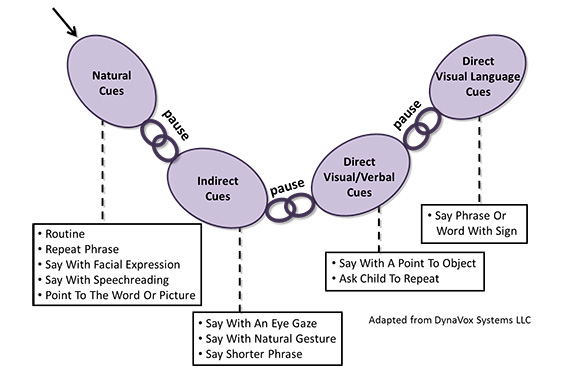Supporting Expressive Language Using A-V Links
In our Teacher’s Choice video clip, you will see the teacher using the A-V Links seen below as a guide for selecting her auditory and visual (A-V) supports. When developing listening and spoken language skills with children who are deaf or hard of hearing, parents, teachers and therapists must plan their communication approach. Children need opportunities for listening as well as supports to ensure understanding.
The A-V Links seen below in a chain formation begin with natural cues (more auditory) on the left and lead to direct visual language cues on the right (more visual). The links can be followed from left to right, adding visual cues gradually, as you help a child understand a spoken message. Notice the connecting links labeled “pause”. After each addition of supports, the child needs time to process and demonstrate whether he understands. If adults never allow for wait time, unnecessary visual supports may be added. There are no rules to using the links. You might jump around the links, deciding to use natural cues, then direct verbal cues, then indirect cues out of order. Just remember to allow wait time for your child to process each step of the message before adding a new support link.

The target phrase for the student is “Time to clean up!” You’ll see that the student omits “to” in a few attempts, saying, “Time clean up!” Follow the play-by-play while viewing the video clip and watch for the strategies in action!
Step one: Teacher presents the target phrase as part of the classroom routine (see Natural Cues): “Time to clean up!” through listening alone.
Step two: Repetition through listening alone with acoustic highlighting (natural cues): The teacher repeats the phrase and highlights the word “to” which was left out by the student.
Step three: Teacher presents the target as two shorter phrases (indirect cue), adds speechreading (natural cue) and signs (direct visual language cue): The teacher slows her rate and breaks the four word phrase into two-word chunks: “time to….clean up”.
Step four: Repetition (natural cue) with visual cues to elicit normal rate and rhythm (indirect cue). The teacher repeats the entire target phrase, using a visual cue (drawing an arc with her finger) to illustrate combining the previously broken down phrase. “Time to clean up!”
Speech and Language;Childhood Deafness
